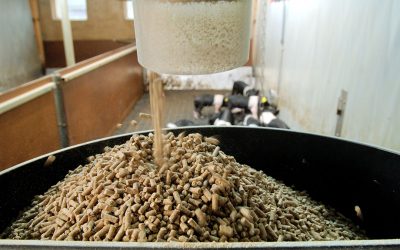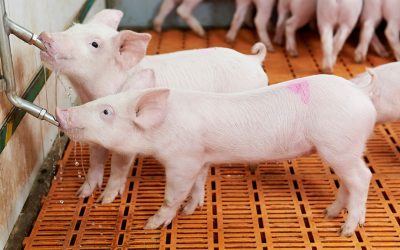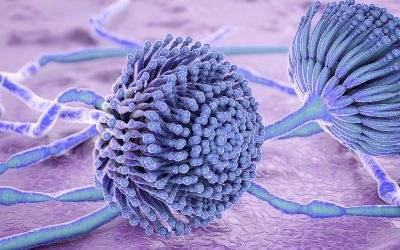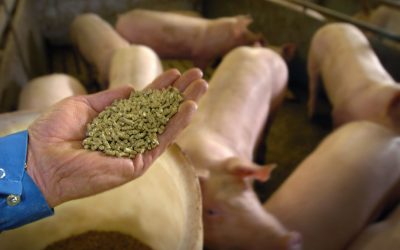Surviving the heat in feed manufacturing
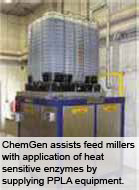
Most pelleting mills operate at temperatures between 70°C – 80°C. Health issues, such as salmonella have created the need for heat treatments or pelleting temperatures in excess of 90°C. Besides a hygienic treatment of the feed, the starch gelatinises, pellet quality is enhanced and digestibility is improved. However, heat sensitive ingredients such as enzymes, vitamins, amino acids, probiotics and antibiotics, must be treated differently.
By Dick Ziggers
“Post-pelleting addition of heat sensitive additives is a way to avoid damage to additives. It also contributes to the reduction of carry-over and cross contamination. The use of liquid additives in a post-pelleting application (PPA) may be an alternative technological solution whereby an even dosing of an additive into animal feed can be provided together with a virtually 100% recovery of the additive.” This introduction was written for the booklet ‘Post-pelleting application of liquid additives’ by G.M.A. Engelen and A.F.B. van der Poel in 1999.
During the past ten years the use of heat sensitive ingredients in feed has significantly increased. The complicating factor is that through quality control programmes, additional demands have been set for the safety of the feeds in terms of harmful bacteria. Apart from specific additives (e.g. acids) to control bacteria, a heat treatment of the feed mash is the best option for a clean feed. And that is where the shoe pinches. Feed additives such as vitamins, enzymes and probiotics do not like high temperatures.
There are three ways to overcome this problem:
• Apply the additives after the heat treatment (PPLA);
• Protect the additives against high temperatures (with coating), or
• Make the additives more heat stable.
Ingredients typically applied through post pelleting liquid application (PPLA) systems are liquid enzymes, fat, molasses, vitamins, trace minerals and medicated feed additives. PPLA is a continuous process that involves complex equipment. Ingredients can be added to the feed through a dry flow system (volumetric, gravimetric, mass flow) or a liquid flow system (mechanical liquid meter, Coriolis meter) or with spray nozzles.
Dosing of liquids
The dosing of liquid products plays a decisive role for the production of animal feed. Fat is relatively easy since it is added at a relatively high percentage. However, enzymes and other heat-sensitive concentrates have changed the paradigm for post-pelleting addition. Inclusion rates of 40 to 250 grammes per tonne of finished feed have created the need for precision equipment. Coefficient of variation, accuracy and precision are some factors that influence the success of any post-pelleting application system.
For example German equipment manufacturer ProMinent has developed the DulcodosSRTmPPLA system to apply liquid additives on animal feed after the pelleting step. High-precision pumps are the core of the installation. The plants are designed modularly and constitute complete solutions for storage, decanting, dosing and application of all kinds of additives.
ProMinent is not involved in the supply of feed ingredients, but companies that do supply additives also take care of the administration of the products to the feed at the mill. However, for small and medium size mills it can be quite expensive to install a PPLA system. Therefore, additive manufacturers assist in applying their products. US based enzyme manufacturer ChemGen markets it Enzymes Application Systems (EAS) to further distribute its enzymes. They can be operated as stand-alone units, or can have different levels of integration to the control & reporting system of the mill. EAS can be tailored to variable numbers of feed lines and multiple enzymes per line. The ChemGen EAS relies on knowledge of the feed flow. Some feed mills have mass flow sensing already in place, such as for fat application, but other mills need some type of mass flow feature added in the process stream. This mass flow sensing works in proximity to the enzyme application point.
To be able to accurately add its phytase product to the feed, German chemical company BASF for a few years now provides technical assistance to help small to medium sized feed mills to design and implement cost-effective PPLA systems. BASF has helped several hundreds of customers successfully implement PPLA technology during the last decade. Its experience is that “feed mills that have implemented PPLA technology have achieved accurate and uniform ingredient application, better process control, and lower production costs.”In addition to the phytase enzyme, PPLA technology can be used for other applications in which greater process control is needed, including fats and oils, molasses, dust suppressants, preservatives and probiotics. Even full-line, multi-species feed mills are excellent candidates for PPLA technology. In fact, if downstream coating equipment is already in place for ingredients such as molasses and fat, it may help make implementation of a PPLA system simpler and less costly.
Mixing and coating
Liquids can simply be sprayed on a flow of feed pellets, but this does not guarantee that every pellet receives the same amount of the additive. They need to be mixed. Dutch equipment manufacturer Van Aarsen designs, produces and supplies batch mixers and other equipment for the animal feed, pet food and aqua feed industry. Their range of MultiMix Twin Shaft Pellet Coaters has been designed for post pelleting applications of liquids and powders. The mixer can also be used to blend a wide range of semi-finished product additives and liquids homogeneously just prior to load out or packing within a short mixing time.
The mixer varies in size from 1,000 to 6,000 litres and can be used as a coater or blender. High speed blending improves mixing performance and effectiveness; especially when using high percentages of liquids or powders during a post pelleting application using multilayer coating techniques. Homogeneity: CV < 10% at 1:100.000 within two minutes.
This mixer is more sophisticated than a basic ingredient mixer, but less complex than a vacuum coater. Especially in the higher margin feeds (pet food, aquafeed) vacuum coating is used to add heat sensitive ingredients to the pellets. With vacuum coating more additives can be sucked into the pellets, because the air in the pores of the pellet is replaced by a liquid additive.
Li et al. (2003) studied vacuum coating in an experimental design. They found no effect of vacuum pressure on the mixing uniformity among pellets. It was found that the smaller the pellets, the smaller the gradient of liquid concentration.
A specialist in vacuum coating is Dinissen in the Netherlands. Their Pegasus vacuum coater is especially suitable for pelleted and extruded products. A vacuum core coater allows you to coat each pellet with precisely the right amount of powder or liquid, which is then distributed deep into the pellet. The result: the highest possible level of homogeneity and precisely the intended effect. Each pellet retains its original shape, and less crumbling also means a reduction in costs associated with the cleaning of transport systems.
A vacuum coater allows the feed mill manager to quickly and effectively apply several layers to pelleted or extruded products. By switching the vacuum on and off, you can allow liquids to penetrate more or less deeply into the pellet, thereby mixing batches of solid and liquid ingredients very quickly and very homogeneously.
Also Forberg in Norway has specialised in vacuum coating. Their Rotating Vacuum Coater was initially developed for coating of extruded aquafeeds and now has been adapted to also add liquid ingredients to pet food. The coater is able to use fat with a melting point higher than ambient temperature with special heat cable tracing of hoses to the nozzles and even tracing of the nozzle assembly itself.
Protecting additives
Especially after the ban on antibiotics in feed in 2006, in Europe a boom in development of additives occurred. Besides the harsh conditions of pelleting the additives also have to withstand other external influences during storage and even in the animal. Therefore, companies started to develop protective coatings. Figure 1shows the effects of a protective coating on enzyme recovery under industrial conditions. Various protection techniques are producing technological ingredients which are resistant to the detrimental effects of light, water, alkaline or acid environments, oxidation, temperature, aggression of metals, mechanical pressure, enzymatic and bacterial degradation.
Micropearls from Soda Feed Ingredients for example are made using a spray freezing technique using very low temperatures (-60°C), which can embed the ingredients in a matrix and shape both matrix and ingredients into a hard microgranule. The matrix used in this process consists of specific vegetable polymers. The protection of organic or inorganic acids, amino acids, vitamins and others is achieved by using this process.
The coacervation technique, through the application of various production steps involving shaking, is able to produce microcapsules containing oil or liquids. The coating used in this process is made from a protein source and silicate. The final product is free-flowing and can resist water, light, temperature, pressure and mixing. It can also pass through the stomach without a loss of activity.
Built-in heat stability
Inborr and Bedford already in 1993 tested enzymes (Avizyme SX) on heat stability. They concluded that the enzyme was destroyed a great deal after pelleting, but this was dependent on the pelleting conditions employed. Higher temperatures and prolonged conditioning times increased inactivation.
Slominska et al. (2007) tested commercially available phytase on resistance against different Canadian processing conditions. At pelleting lines that had an output temperature of 70°C the loss of endogenous phytase varied from 42% – 58% depending on the type of enzyme. The Canadian researchers concluded that the heat stability of enzyme per se rather than the granulation technology is a primary factor determining the stability of microbial phytase during steam pelleting.
Research is moving towards a better intrinsic heat stability of enzymes. Novozymes recently introduced a new phytase with better heat stability. Based on the findings of several customer trials, the product further increases the availability of phytate phosphorus and other phytate nutrients in pig and poultry feeds, whilst being the most heat-stable phytase product form in the market.
Improvements in heat stability are attributed to the higher intrinsic heat stability of the phytase molecule in combination with the next generation computer aided formulation technology. This combination of technologies provides protection at feed processing temperatures up to 95°C. In future heat stable enzymes that can resist temperatures higher than 100°C are foreseen. Perhaps this will enlighten feed processing when they can directly be added to the base mix.
Noordwes Voere installs PPLA
Noordwes Voere last year installed a new post pellet application system at their plant in Lichtenburg, South Africa. According to Leon Venter, production manager at Noordwes Voere, the company decided to purchase the Andritz (Sprout Matador) Micro Fluid System (MFS 500). This system is currently the most innovative design from Andritz in Denmark. It has already been tested thoroughly and there are more than 35 units successfully in operation in Europe. The system has the facility to apply various micro-liquids at levels as low as 0,0125%. It also has a facility to spray oil to a maximum of 5% onto the pellets after pelleting. The most unique feature of the MFS 500, which finally convinced Noordwes Voere to use this system, is its accuracy. Information of three measuring instruments is fed to a computer which processes the information which is then used to calibrate the micro and macro liquid control systems. The control systems then regulate the pumps that spray the liquid onto the feed.
The pumps push the liquid into a set of spray nozzles, where the liquid is then sprayed in the form of a fine mist into the free-falling stream of pellets. Directly after application, the pellets are loaded onto the truck for dispatch to the customer. John Veenstra, technical manager at Noordwes Voere, says this is the latest technology available in South Africa. “This new system enables us to apply oil to already manufactured broiler pellets. Thus it improves the quality of the pellet and allows for increased energy levels in the feed. This device can also be used to apply heat sensitive enzymes, if necessary.”
Source: FeedTech vol 14 nr 1, 2010




